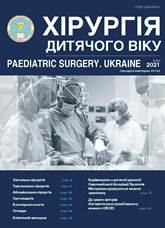Spatial substantiation of linear parameters of biopsy in histological examination of pigmented skin neoplasms in children
DOI:
https://doi.org/10.15574/PS.2021.71.6Keywords:
children, melanocyte nevi, operative accessesAbstract
Usually the lower part of melanocyte nevi is at a depth of not more than 1–2 mm or more, which is typical for congenital nevi, as well as for large pigmented tumors that protrude significantly above the skin surface and have a pronounced intradermal part. Incomplete removal of pigmented nevi occurs during their superficial removal with insufficient capture of healthy tissues. When excision of pigmented nevi by acute method means in the vast majority of cases of incomplete removal can be avoided, and primarily because the suturing of the edges of the postoperative wound requires much deeper excision of tissues.
Рurpose – to increase the effectiveness of surgical treatment of pigmented skin tumors in children by using a mathematical model.
Materials and methods. The study was conducted on the basis of the oncohematology department of Vinnytsia Regional Children’s Clinical Hospital, a mathematical model for calculating the parameters of operational access was conducted on the Microsoft Excel platform.
Results. Using the proposed mathematical model, the following parameters of the operating material were calculated: the area of the resection edges of the operating material; the area of the base of the operating material; the total area of morphological examination of the surface of the surgical material; determining the difference in the volume of surgical material to be histologically examined by different methods of its collection. In all cases, the tumor for three-dimensional histological examination was excised in the form of an ellipse with a safety zone (healthy tissue around the tumor). The surgical direction of the incision was formed with an inclination to the surface of the skin towards the tumor with the formation of an acute angle with it, while the upper part of the dermis was cut less than its lower part. This approach to the formation of the profile of the surgical wound improves the conditions for further reconstructive wound defect closure.
Conclusions. Comparative mathematical calculation according to the proposed spatial geometric model of the biopsy in the form of a truncated elliptical cone convincingly shows an increase in the useful volume of surgical material in the planned histological examination compared with the cylindrical elliptical configuration of the biopsy due to involvement in the field of microscopic structures «residual structures» (processes) corresponding to melanocyte nevi, under the guise of which the development of the initial stages of melanoma may occur.
The research was carried out in accordance with the principles of the Helsinki declaration. The study protocol was approved by the Local Ethics Committee of these Institutes. The informed consent of the patient was obtained for conducting the studies.
The authors declare no conflicts of interests.
References
Chung C, Forte AJV, Narayan D, Persing J. (2006). Giant nevi: a review. Journal of Craniofacial Surgery. 17 (6): 1210-1215. https://doi.org/10.1097/01.scs.0000231619.95263.a2; PMid:17119398
Maher M, Janardhanan P, Singh S. (2017). Novel use of surgical caliper in excision of cutaneous melanomas. Open Access J Surg. 3 (6): 25-32. https://doi.org/10.19080/OAJS.2017.06.555692
Makkar HS, Frieden IJ. (2002). Congenital melanocytic nevi: an update for the pediatrician. Current opinion in pediatrics. 14 (4): 397-403. https://doi.org/10.1097/00008480-200208000-00007; PMid:12130901
Reddy KK, Farber MJ, Bhawan J, Geronemus RG, Rogers GS. (2013). Atypical (dysplastic) nevi: outcomes of surgical excision and association with melanoma. JAMA dermatology. 149 (8): 928-934. https://doi.org/10.1001/jamadermatol.2013.4440; PMid:23760581
Zitelli JA, Brown CD, Hanusa BH. (1997). Surgical margins for excision of primary cutaneous melanoma. Journal of the American Academy of Dermatology. 37 (3): 422-429. https://doi.org/10.1016/S0190-9622(18)30743-6
Downloads
Published
Issue
Section
License
The policy of the Journal “PAEDIATRIC SURGERY. UKRAINE” is compatible with the vast majority of funders' of open access and self-archiving policies. The journal provides immediate open access route being convinced that everyone – not only scientists - can benefit from research results, and publishes articles exclusively under open access distribution, with a Creative Commons Attribution-Noncommercial 4.0 international license(СС BY-NC).
Authors transfer the copyright to the Journal “PAEDIATRIC SURGERY.UKRAINE” when the manuscript is accepted for publication. Authors declare that this manuscript has not been published nor is under simultaneous consideration for publication elsewhere. After publication, the articles become freely available on-line to the public.
Readers have the right to use, distribute, and reproduce articles in any medium, provided the articles and the journal are properly cited.
The use of published materials for commercial purposes is strongly prohibited.

